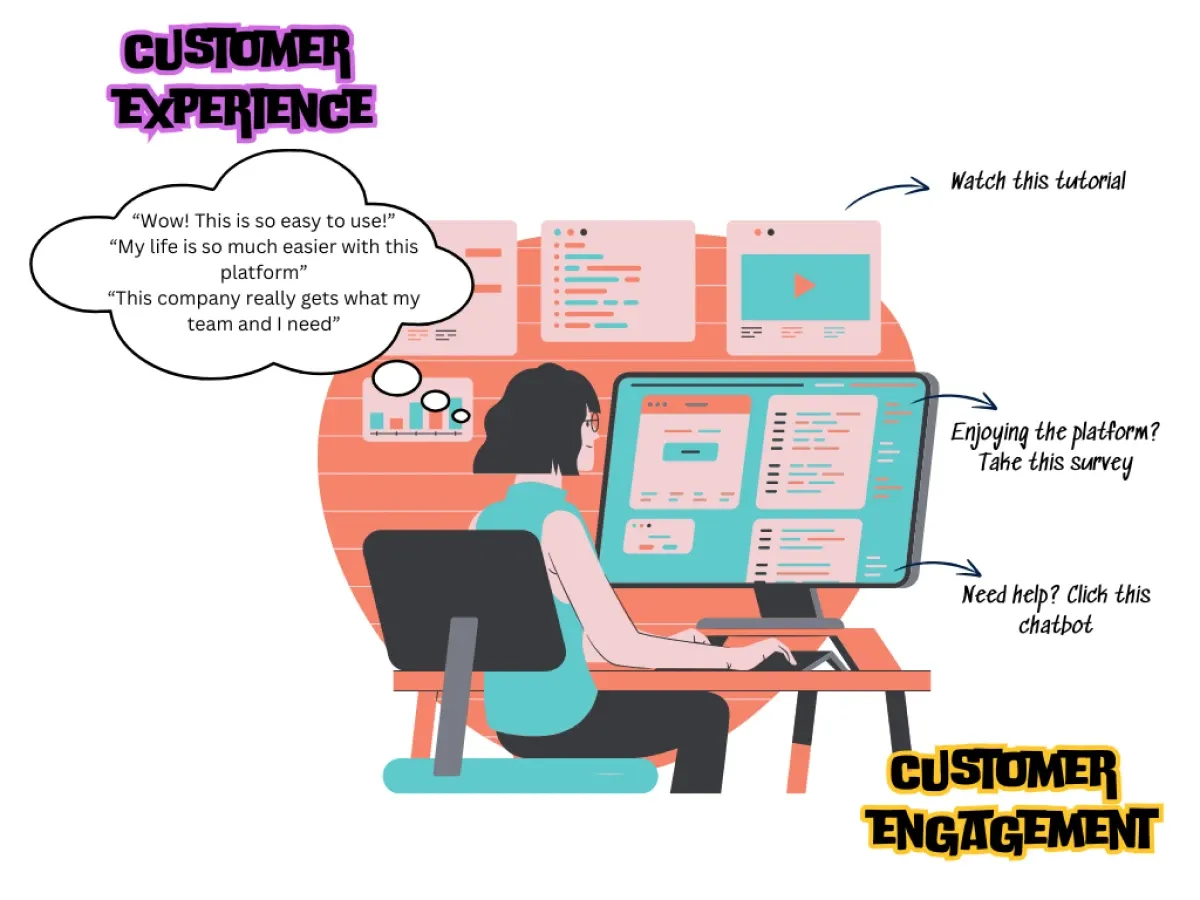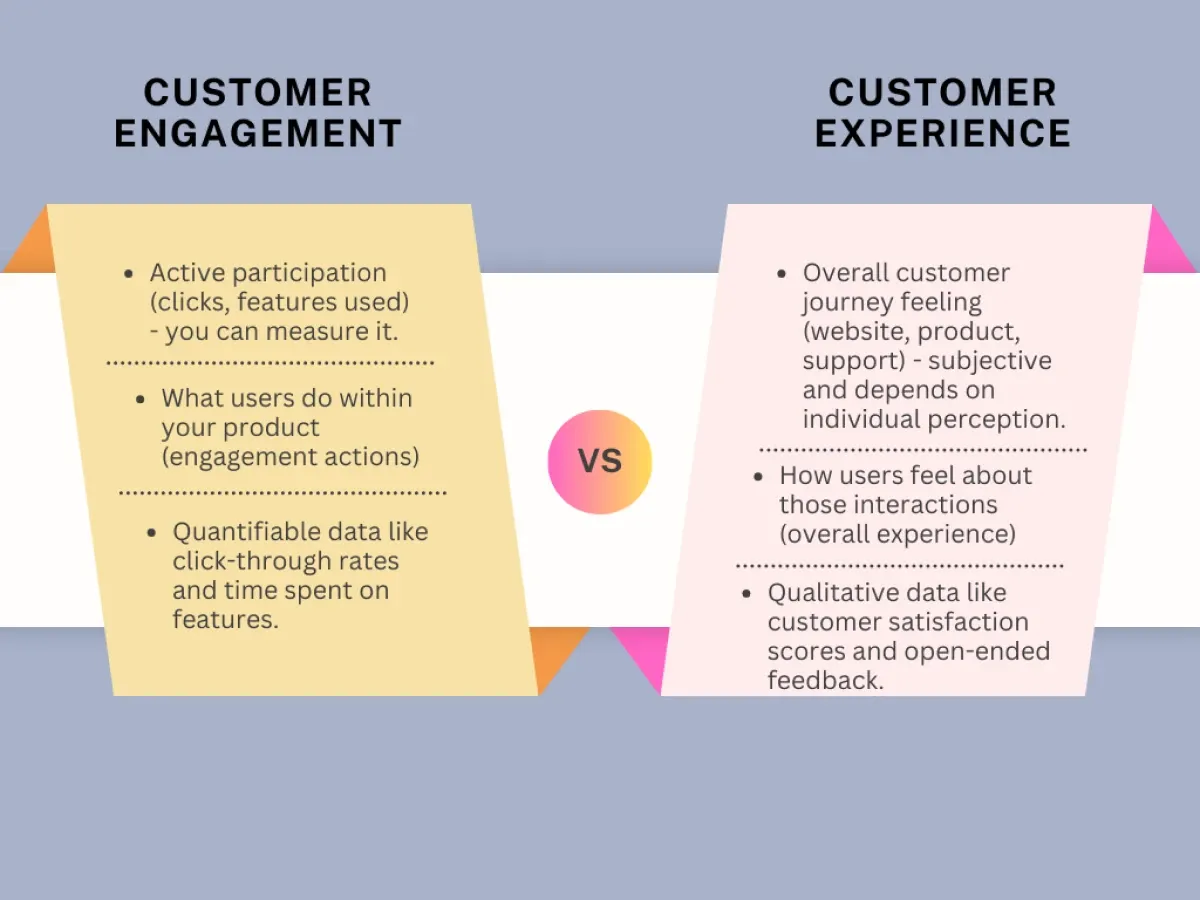Customer engagement vs. customer experience: CE is the spark, CX is the fire
Confused by the terms "customer engagement" and "customer experience"? This article breaks down the key differences and explains why you need both for a successful B2B business strategy.

Customer engagement (CE) and customer experience (CX) are often used interchangeably. They sound so similar that you can easily mistake one for another, like two roommates who keep borrowing each other’s clothes.
But there’s a vast difference between a quick, random like on a social media post (that’s customer engagement) and a five-star review (definitely a sign of a great customer experience).
Grasping the subtle distinctions between these concepts is crucial for B2B businesses. It determines whether your focus will be on getting users to interact with your product (i.e. engagement) or creating a holistic, positive journey for them throughout their entire interaction with your brand and its products and services (i.e. experience).
Research by Salesforce shows that 80% of customers prioritize the experiences a company provides just as much as the products and services themselves. When customer engagement fuels a positive customer experience, it creates a powerful loop. Satisfied customers become repeat customers, and their positive word-of-mouth attracts new ones. This virtuous cycle is the holy grail of successful business strategy.
Demystifying customer engagement and customer experience
Have you ever noticed how a simple handshake can tell you a lot about a person? It's the same with customer interactions. Every touchpoint, from using your platform to chatting with a sales rep or commenting on social media, is a handshake between your business and your customer.
Customer engagement: This is about those moments of active participation. It's actions like clicking on a button within your app, sharing a post about your brand, or leaving a review. These interactions are measurable and show how users are actively engaging with your product or service.
Customer experience: This is the bigger picture. It's the sum total of feelings a customer has about interacting with your brand, just like the impression you get from a handshake. It encompasses all the touchpoints, not just the active ones. But unlike CE, CX is subjective.
Think back to the handshake analogy. A firm, warm handshake conveys confidence and makes a positive impression. A weak, limp handshake might leave you feeling indifferent. The feeling a customer has during each interaction aka "the handshakes" contributes to their overall CX.

A smooth and seamless experience across all touch-points (website navigation, product quality, customer service interactions) leads to a positive CX. Conversely, a frustrating experience with any element can negatively impact the CX.
In a nutshell:
- CE: What customers do (active participation).
- CX: How customers feel about those interactions (overall impression).
How customer engagement and customer experience fit into the customer journey
The customer journey is a map that traces a customer's entire experience with your brand, from initial awareness to post-purchase interactions. It's the perfect lens through which to understand the interplay between customer engagement and customer experience from the customer's perspective.

Customer engagement is direct and happens in-product (mostly)
Let's zoom in on the specific actions within the product. This is where customer engagement comes into play. CE focuses on those moments of active participation, where customers directly interact with your product or service.
Here are some examples:
- User behavior within the app: How customers navigate the interface, what tabs or features they click on, and how frequently they use specific functionalities.
- Clicks on features: Analyzing which features users engage with most helps identify areas of interest and potential areas for improvement.
- Frequency of use: How often customers return to your product is a strong indicator of engagement. Understanding usage patterns can help your product team tailor features and content to keep users coming back for more.
- Time spent on specific functionalities: Examining how much time users spend on different functionalities within the product reveals what the users are truly interested in. This data can be used to optimize features and improve user experience.
The subjective nature of customer experience
While CE focuses on measurable actions, customer experience is highly subjective. Every customer defines a "good" experience differently.
Several factors contribute to this perception:
- Brand personality: The overall tone, voice, and image your brand projects influence how customers feel about interacting with it.
- Emotional connection: Building an emotional connection with customers is paramount – it fosters loyalty and creates a more positive CX.
- Effort required to accomplish tasks: A streamlined and user-friendly experience, especially within your platform or app, where tasks require minimal effort leads to a more positive perception.
Let’s take the case of a B2B project management software.
A customer who prioritizes efficiency might find the software's intuitive interface design and pre-built templates to be a positive experience because they can quickly onboard new teams and get them working faster.
Another customer might prioritize customization and ongoing support. For them, a positive CX would involve a dedicated account manager readily available to answer questions and provide tailored training sessions, ensuring they can fully leverage the software's capabilities, as and when they need it.
Each defines the “experience” they have with a business differently and it is quite possible that one has a positive while the other has a negative customer experience even if they are engaged in the same way across the same channels.
How customer engagement and customer experience teams work in tandem
From a business’s perspective, both CE and CX are important and the work your teams do in these areas needs to support each other.
The customer engagement team is laser-focused on optimizing in-product behavior
The customer engagement team acts as the bridge between users and the product. Their primary focus is on:
- Measuring and analyzing user data: This involves analyzing user data (clickstream data, heatmaps, time spent on features) to understand how users interact with the product, identify areas for improvement, and personalize the experience – a highly sought "feature" in B2B products (in fact, 65% of consumers say they will remain loyal to companies that offer a more personalized experience.)
- Fostering a sense of value: By creating "engagement loops" through A/B testing features, messaging, and user flows, the CE team keeps users motivated and promotes repeat usage. This can include optimizing user onboarding to improve discoverability, implementing loyalty programs, or tailoring in-app notifications.
Metrics that matter:
- User behavior data: This provides insights into how users behave and why they “X” instead of “Y” within the product.
- Click-through rates for calls to action: This measures the effectiveness of prompts or buttons that encourage users to take specific actions within the product.
- Conversion rates for desired user actions: This tracks the percentage of users who complete specific actions, such as signing up for a premium plan or completing a tutorial.
The right metrics to include in your customer engagement strategy ultimately depend on whether revenue, profitability, or relationship growth are your primary objectives.
The customer experience team takes on a holistic view of the entire customer journey
The customer experience team takes a broader perspective, encompassing the entire customer journey, not just in-product interactions. They collaborate with various teams (product, marketing, sales, customer success) to ensure a seamless and positive experience across all touch-points:
- Product management: Ensures features align with customer needs and challenges.
- Marketing: Creates engaging messaging and experiences through targeted campaigns.
- Sales: Provides a smooth and personalized buying experience.
- Customer success: Offers ongoing support and ensures customers achieve their desired outcomes.
Metrics that matter:
- Customer sentiment: Using metrics like customer satisfaction score (CSAT), net promoter score (NPS), and brand sentiment analysis, they assess customer feelings towards the brand. Tools like Command AI’s Surveys can help you with this.
- Customer lifetime value (CLTV): This metric tracks the overall value a customer brings to the business over time.
Not synonymous, but synchronous
Customer experience and customer engagement, even though not synonymous, should not be treated as isolated concepts. For a SaaS business looking to maintain a strong footing in the market, making the two work together is important.
Positive engagement fuels positive CX. Effective customer engagement efforts within the product lead to positive customer experiences. When users feel valued, and motivated, and have a sense of accomplishment through well-designed features and engagement loops, they develop a positive association with the brand.
From the other point of view, positive CX breeds higher engagement. If you feel good about something, you're bound to go back to it. Your favorite flavor of ice cream, your favorite book, your best friend – all are examples of things you trust and want more of. The same is true of customer experience. When a business provides positive, frictionless experiences, customers feel happy about it, they trust you and want to return to you. Happy customers are also more likely to become advocates for the brand. They might participate in discussions on social media, open marketing emails at higher rates, and be more receptive to in-product prompts for further exploration.
By understanding the subtle differences between the two you can make sure that customer engagement and customer experience work in sync so that your SaaS business can create a powerful engine that drives loyalty and fuels sustainable customer growth.
